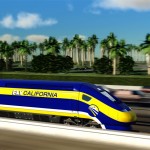
Governor Newsom’s “State of the State” speech today offered an abrupt scaling back of the state’s vision for its signature infrastructure project, high speed rail from Los Angeles to San Francisco:
[L]et’s level about high speed rail. I have nothing but respect for Governor Brown’s and Governor Schwarzenegger’s ambitious vision. I share it. And there’s no doubt that our state’s economy and quality of life depend on improving transportation. But let’s be real. The project, as currently planned, would cost too much and take too long. There’s been too little oversight and not enough transparency. Right now, there simply isn’t a path to get from Sacramento to San Diego, let alone from San Francisco to L.A. I wish there were. However, we do have the capacity to complete a high-speed rail link between Merced and Bakersfield.
In some ways, his position is a simple nod to fiscal reality. There aren’t enough funds right now to complete the project beyond this initial phase in the Central Valley anyway. Voters approved roughly $10 billion in bond funding in 2008, the 2009 federal “stimulus” bill offered another $3.5 billion, and Governor Brown and the legislature dedicated about 25% of cap-and-trade auction proceeds to continue building the system.
But that’s not enough to connect the Central Valley portion through the Pacheco Pass into San Jose, where it could then connect to the soon-to-be-electrified Caltrain into San Francisco. And it’s nowhere near the multiple billions of dollars needed to tunnel through the Tehachapi Mountains to connect to Southern California.
The key is the federal government: with Republicans in complete control of Congress from 2011 until last month, they were unwilling to match the state’s investment with federal dollars. While highway projects will get 90-100% funding from the federal government and intracity rail transit will get 50%, high speed rail has gotten just about 15% in federal matching funds — and only from that one-time 2009 stimulus grant.
If California had received closer to a 50% match from the federal government, the rail system would have the money to connect to the Bay Area. That link would provide significant economic benefits for Central Valley cities like Fresno and Merced by connecting them to the prosperous coastal economy. And it would create immediate benefits to bolster the long-term political support needed to eventually extend the system to Southern California.
But Governor Newsom’s speech today shows that he’s unlikely to spend much political capital to fight for these federal dollars from a congress that now features many California representatives, including the speaker, in control of the House of Representatives. It’s a position consistent with his 2014 interview in which he stated he would redirect funds from the system to other infrastructure needs.
Instead, his scaled-back vision presents a message that may confirm critics’ charges that the system is flawed and potentially infeasible. Some also worry that the new plan will embolden more litigants, arguing that the change in project vision violates the terms of that original 2008 bond initiative, although the courts have so far been deferential to state leaders on this question.
High speed rail backers will ultimately need a change in federal leadership come 2021 to get the necessary funds to complete the project — but it looks like they will have only tepid support from the state’s new governor in the meantime.


